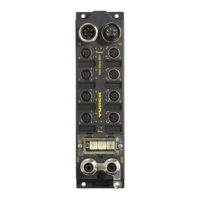Implementation of Modbus TCP
D301271 1013 - FGEN - multi protocol9-2
9.1 Common Modbus description
Modbus is an application layer messaging protocol, positioned at level 7 of the OSI model, that provides
client/server communication between devices connected on different types of buses or networks.
The industry’s serial de facto standard since 1979, Modbus continues to enable millions of automation
devices to communicate. Today, support for the simple and elegant structure of Modbus continues to
grow.
The Internet community can access Modbus at a reserved system port 502 on the TCP/IP stack.
Modbus is a request/reply protocol and offers services specified by function codes. Modbus function
codes are elements of Modbus request/reply PDUs (Protocol Data Unit).
It is currently implemented using:
TCP/IP over Ethernet. (that is used for the FGEN-modules and described in the following)
Asynchronous serial transmission over a variety of media (wire: RS232, RS422, RS485, optical: fiber,
radio, etc.)
Modbus PLUS, a high speed token passing network.
Schematic representation of the Modbus Communication Stack (according to Modbus Application
Protocol Specification V1.1 of Modbus-IDA):
Note
The following description of the Modbus protocol is taken from the Modbus Application
Protocol Specification V1.1 of Modbus-IDA.
Figure 9-1:
Schematic
representation
of the Modbus
Communica-
tion Stack
Modbus Application Layer
Modbus TCP
TCP
IP
andere
Master/Slave
Client/Server
Physical layer
Modbus plus
Physical layer
Rsxxx
Physical layer
Ethernet
Physical layer
Modbus Application Layer
Modbus TCP
TCP
IP
andere
Master/Slave
Client/Server
Physical layer
Modbus plus
Physical layer
Rsxxx
Physical layer
Ethernet
Physical layer

